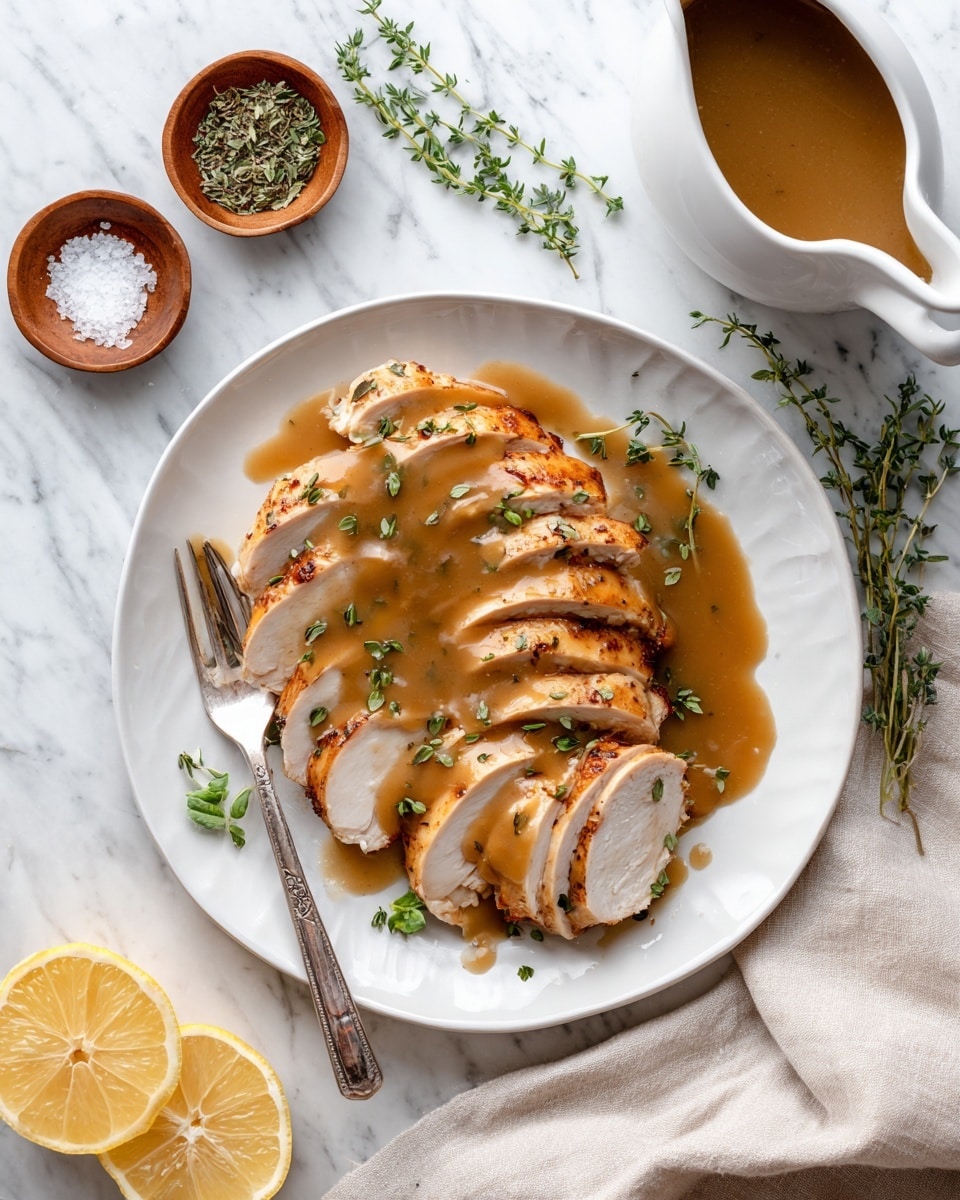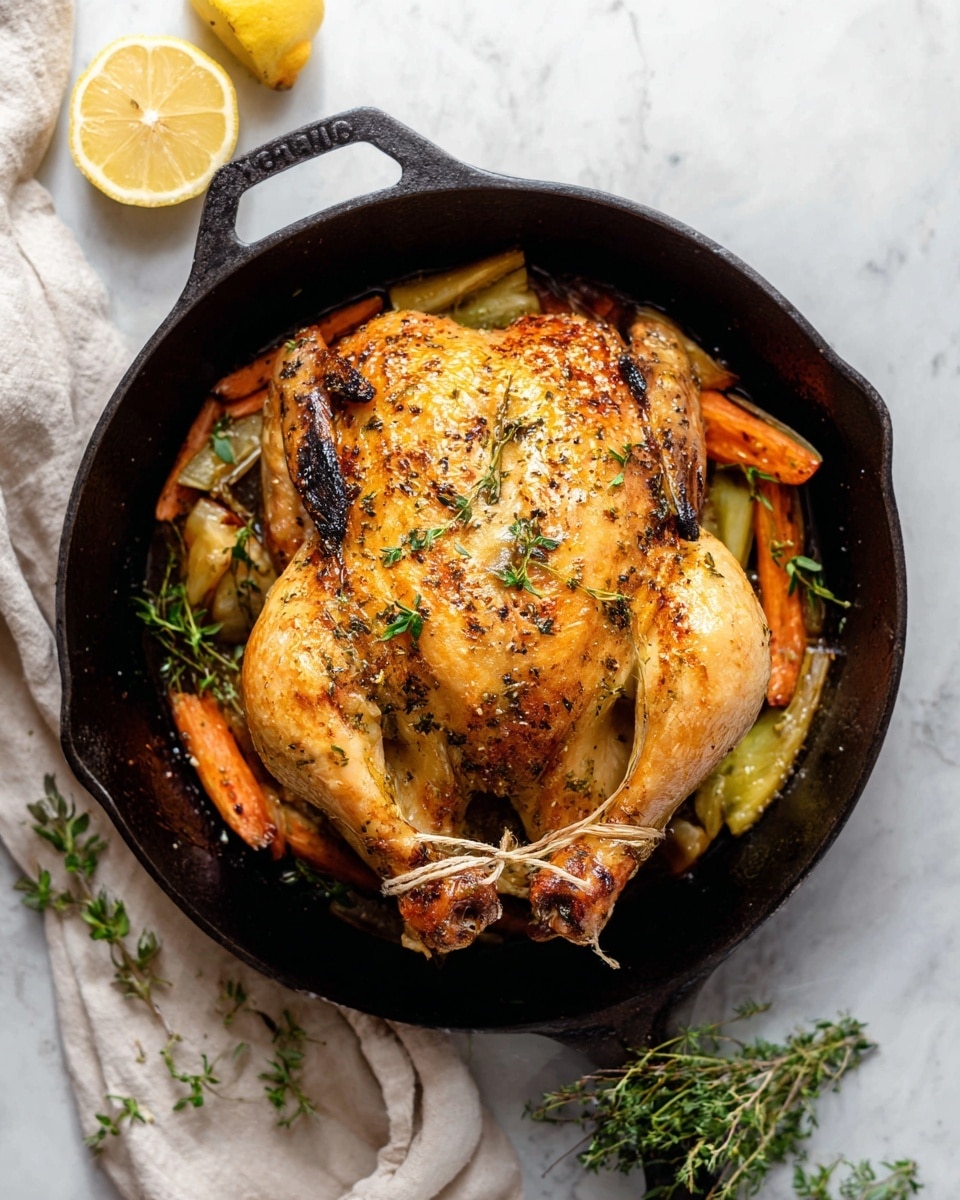If you’re on the hunt for a comforting, foolproof dinner, I can’t recommend The Best Roast Chicken Recipe enough. It’s juicy, beautifully golden, and packed with flavor that seeps deep into the meat—plus, it’s surprisingly simple to nail every single time. When I first tried this, I was amazed at how the classic flavors come together so effortlessly. Stick with me, and I’ll show you how to make this show-stopper right in your own kitchen.
Why You’ll Love This Recipe
- Crispy, golden skin: The olive oil and butter combo gives you that perfect, crackly exterior every time.
- Deep, aromatic flavors: Stuffing the cavity with garlic, lemon, and thyme infuses the meat with natural, bright notes.
- Effortless prep: Minimal ingredients and straightforward steps make this great for both beginners and seasoned cooks.
- Versatility: Whether it’s a weeknight dinner or special gathering, this roast chicken always impresses.
Ingredients You’ll Need
These ingredients are simple staples that come together beautifully. I always recommend using fresh herbs and a good quality butter and olive oil—trust me, they really elevate the dish.
- Carrot: Adds sweetness and aroma when roasted beneath the chicken.
- Celery: Gives a subtle flavor base and keeps the chicken elevated for even cooking.
- Whole chicken: Fresh, patted dry—the star of the show. Dry skin means crispy skin!
- Unsalted butter: Use melted butter to get that rich, golden skin without extra saltiness.
- Garlic (minced): Mixed with butter to tie flavors inside and under the skin.
- Fresh thyme: Offers a woodsy, herby note that pairs perfectly with citrus.
- Lemon zest: Brightens the flavor and provides a hint of fresh citrus aroma.
- Olive oil: Helps crisp up the skin and adds richness.
- Salt & freshly cracked black pepper: Essential for seasoning and enhancing the natural flavors.
- Head of garlic (whole, sliced top): Roasts inside the cavity for mellow, buttery garlic flavor.
- Yellow onion: Adds sweetness and moisture when placed inside the cavity.
- Lemon (halved): Packed inside the chicken cavity—infuses juicy, tangy notes.
- Fresh thyme sprigs: For aromatic stuffing inside the bird, amplifying herbal fragrance.
Variations
I love how flexible this recipe is. You can tweak it based on what you have or your mood, and it still ends up amazing. Plus, experimenting keeps things fun in the kitchen.
- Herb swaps: If thyme isn’t your thing, rosemary or sage work beautifully; I swapped once on a whim and loved the earthier twist.
- Spice things up: Add smoked paprika or a pinch of cayenne to the butter rub for a subtle kick—I did this for a cozy fall dinner and my family went crazy for it.
- Stuffing options: Try stuffing the cavity with fresh apples and onions for a slightly sweet profile perfect for autumn gatherings.
- Butter alternative: Use olive oil instead of butter for a dairy-free version; while it changes the richness, the skin still crisps up nicely.
How to Make The Best Roast Chicken Recipe
Step 1: Prep Your Veggies and Oven
Start by preheating your oven to 400°F (200°C). While it warms up, cut the carrot in half lengthwise, then into thirds, and chop celery into chunky thirds. These veggies are your roasting rack—they lift the chicken so air circulates evenly, giving you delicious, crisp skin all around.
Step 2: Mix Your Flavor-Packed Butter Rub
In a small bowl, combine melted unsalted butter, minced garlic, fresh thyme, and grated lemon zest, along with a pinch of salt and freshly cracked black pepper. This mixture is where all the magic begins—it flavors the meat and keeps it moist. When I discovered rubbing this under the skin, my roast chicken took on an entirely new level of juiciness and aroma.
Step 3: Prepare the Chicken
Pat the chicken dry with paper towels—this is crucial because a dry surface means crispier skin. Place it breast side up on top of your veggies in a cast iron skillet or heavy roasting pan. Carefully loosen the skin to rub half of your butter mixture underneath—this step gives you that extra flavor burst right where it counts. Don’t skip rubbing the inside of the cavity, too, using the remaining butter mixture for deep, fragrant seasoning.
Step 4: Stuff the Cavity and Tie Up
Stuff the chicken cavity with the halved lemon, yellow onion pieces, the garlic head (topsliced), and fresh thyme sprigs. I like to secure the drumsticks with kitchen twine to keep everything compact for even cooking, but it’s completely optional. This little trick helps keep the juices inside while roasting, making each bite super tender.
Step 5: Oil, Season, and Roast
Drizzle olive oil over the entire chicken and use a basting brush to coat the skin thoroughly. Then, sprinkle generously with salt and freshly cracked black pepper. Pop the skillet into the middle rack of your oven and roast for about 1 hour and 15 to 30 minutes. I like to baste the chicken every 30 minutes, which keeps the skin moist and helps it brown beautifully. The secret is patience here—give it time, and you’ll see a golden masterpiece emerging.
Step 6: Rest Before Carving
Once your thermometer hits 165°F in the thickest part of the thigh, take the chicken out and let it rest for 10-15 minutes right in the pan. This resting period is essential—trust me, skipping it meant drier meat in the past. The juices redistribute, so when you carve, everything stays moist and juicy.
Pro Tips for Making The Best Roast Chicken Recipe
- Pat Dry Seriously: I learned the hard way that a damp bird ruins crisp skin—so dry it thoroughly before anything else.
- Under-Skin Butter Magic: Rubbing that butter mixture beneath the skin makes the biggest difference in flavor and moisture.
- Elevate With Veggies: Roasting on carrots and celery means no soggy bottom—it lifts the chicken for even heat distribution.
- Don’t Skip Resting: Letting the chicken rest after roasting locks in the juices—I never skip this step anymore.
How to Serve The Best Roast Chicken Recipe

Garnishes
I like to garnish with a sprinkle of freshly chopped parsley or more fresh thyme sprigs to add a pop of color and fresh aroma right before serving. Sometimes, I even squeeze a little extra lemon juice over the carved chicken—it brightens the whole dish in the best way.
Side Dishes
My go-to sides? Roasted potatoes tossed with rosemary, a simple green salad dressed with lemon vinaigrette, and some garlicky sautéed green beans. These balance the hearty roast perfectly—plus, they’re easy to pop in the oven or skillet while the chicken roasts.
Creative Ways to Present
For special occasions, I like to serve the carved chicken on a large wooden board surrounded by roasted baby vegetables and lemon wedges. It’s casual yet elegant, perfect for family-style dinners or cozy holiday meals. Adding colorful edible flowers is another fun touch I’ve tried for dinner parties, and guests love the surprise.
Make Ahead and Storage
Storing Leftovers
I always store leftover chicken in an airtight container in the fridge, ideally within two hours of cooking. It stays juicy for about 3-4 days. Leftover veggies? I love reheating them alongside the chicken for a quick meal.
Freezing
While I prefer fresh, I’ve frozen carved roast chicken successfully by wrapping pieces tightly in plastic wrap and then foil. When ready to eat, thaw overnight in the fridge. Freezing may slightly change texture but works great for soups or chicken salads later.
Reheating
For reheating, I warm chicken in a 350°F oven covered loosely with foil to keep it moist. Avoid microwaving if you can; the oven brings back crisp skin and tender meat better. Adding a splash of chicken broth during reheating helps maintain juiciness.
FAQs
-
Can I use frozen chicken for this recipe?
It’s best to use a fully thawed chicken to ensure even cooking and the best texture. If you must use frozen, thaw it completely in the fridge for 24 hours before roasting.
-
How do I know when the chicken is done?
The most reliable method is using a meat thermometer—insert into the thickest part of the thigh; it should read 165°F. Alternatively, juices running clear when pierced is a sign, but temperature is safer.
-
Can I roast this chicken without the vegetables underneath?
You can, but the vegetables help with flavor and keep the chicken elevated for more even cooking. Without them, the bottom might get soggy or less crispy.
-
What if I don’t have fresh thyme?
Dried thyme can be substituted, but use about half the amount since dried herbs are more concentrated. Alternatively, rosemary or sage give lovely flavors as well.
Final Thoughts
Honestly, The Best Roast Chicken Recipe has become my go-to comfort food, the dish I return to when I want something impressive yet simple. The way it fills the house with those warm, inviting aromas… it’s pure magic. I hope you give this recipe a try—you’ll be amazed how a few basic ingredients and a little love turn into a meal your family will swear by, just like mine does now.
Print
The Best Roast Chicken Recipe
- Prep Time: 10 minutes
- Cook Time: 75 minutes
- Total Time: 1 hour 25 minutes
- Yield: 6 servings
- Category: Main Dish
- Method: Roasting
- Cuisine: American
Description
A succulent and flavorful roasted chicken recipe featuring a perfectly seasoned whole bird cooked atop fresh vegetables, infused with garlic, lemon, and thyme, resulting in tender, juicy meat with crispy skin. Ideal for a comforting dinner or special occasion.
Ingredients
Vegetables
- 1 large carrot, halved lengthwise and cut into thirds
- 1 stalk celery, cut into large thirds
Chicken and Seasoning
- 1 whole chicken (2-4 pounds), giblets removed and patted dry
- 1/4 cup unsalted butter, melted
- 3 cloves garlic, finely minced
- 1/2 teaspoon fresh thyme
- 1/2 teaspoon grated lemon zest
- 3 tablespoons olive oil
- Salt, to taste
- Freshly cracked black pepper, to taste
For the Cavity
- 1 head of garlic, top sliced off
- 1/2 yellow onion, cut into 2 large pieces
- 1 lemon, cut in half
- 4-6 sprigs fresh thyme
Instructions
- Preheat Oven: Preheat the oven to 400 degrees Fahrenheit to ensure it reaches the ideal roasting temperature.
- Prepare Butter Mixture: In a small bowl, combine the melted butter, minced garlic, lemon zest, 1/2 teaspoon fresh thyme, and a generous pinch of salt and freshly cracked black pepper to create a flavorful rub.
- Arrange Vegetables: Place the cut celery and carrots in a cast iron skillet or oven-safe pan to serve as a base that adds flavor and elevates the chicken.
- Pat and Position Chicken: Use a paper towel to pat the chicken dry thoroughly, then place it breast side up on top of the vegetables in the skillet.
- Apply Butter Mixture: Gently rub the melted butter mixture under the skin and inside the cavity of the chicken to maximize flavor and moisture, using all of the butter preparation.
- Stuff Chicken Cavity: Fill the cavity with the whole head of garlic (top sliced off), pieces of yellow onion, halved lemon, and sprigs of fresh thyme to infuse aromatic flavors while roasting. Optionally, tie the drumsticks together with kitchen twine for even cooking.
- Oil and Season Skin: Drizzle olive oil over the chicken skin and use a basting brush to evenly coat it. Liberally season the chicken’s exterior with salt and freshly cracked black pepper.
- Roast Chicken: Place the skillet on the middle rack of the preheated oven and roast for 1 hour and 15 to 30 minutes. Baste the chicken every 30 minutes to keep the skin moist and flavorful. Cook until the internal temperature reaches 165°F at the thickest part.
- Rest Chicken: Remove the chicken from the oven and let it rest in the skillet for 10 to 15 minutes to allow juices to redistribute for optimum juiciness.
- Carve and Serve: Carve the chicken and serve it with the pan drippings, or save the drippings to make homemade chicken gravy for an extra touch of richness.
Notes
- Use a meat thermometer to ensure the chicken is cooked to a safe internal temperature of 165°F.
- Resting the chicken after roasting is crucial for juicy meat and easier carving.
- Kitchen twine is optional but helps the chicken cook evenly and maintain shape.
- The vegetables under the chicken can be served alongside or removed before carving.
- Pan drippings can be used to make a delicious gravy or sauce.
Nutrition
- Serving Size: 1 serving (approx. 1/6 of the chicken)
- Calories: 350 kcal
- Sugar: 2 g
- Sodium: 350 mg
- Fat: 22 g
- Saturated Fat: 8 g
- Unsaturated Fat: 12 g
- Trans Fat: 0 g
- Carbohydrates: 4 g
- Fiber: 1 g
- Protein: 35 g
- Cholesterol: 110 mg




Your email address will not be published. Required fields are marked *